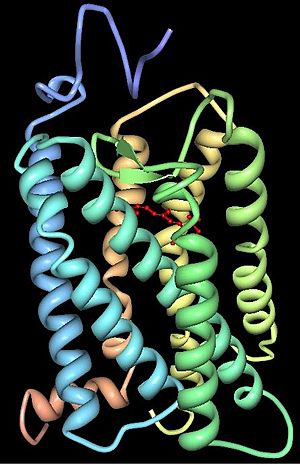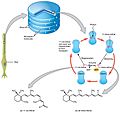Opsin facts for kids
Opsins are special molecules found in the eyes of almost all animals. They are like tiny light-sensing switches that help us see.
When light hits an opsin molecule, it changes shape. This change starts a chain reaction inside the cell. This chain reaction sends a signal that eventually goes to the brain, allowing animals to see. This whole process of turning light into a signal is called phototransduction.
There are five main types of opsins that help animals see. Another type, called melanopsin, is found in the eyes of mammals. It helps with your body's internal clock (like knowing when to sleep) and how your pupils react to light. But it doesn't help you see pictures or images.
How Opsins Help Us See Colors
The number of different opsins an animal has often affects how many colors it can see.
- If an animal has only one type of opsin, it sees the world in just one color, like a black and white movie.
- Most mammals, like dogs and cats, have two types of opsins. This lets them see in two main colors, usually blues and yellows.
- Animals like fish, reptiles, and birds often have four types of opsins. This gives them full color vision, allowing them to see many more colors, similar to how humans see.
Among mammals, only Old World monkeys, apes, and humans can see in full color. Scientists think that mammals lost some of their color vision a long time ago. This happened during the Mesozoic Era, because many early mammals lived mostly at night. Seeing in full color wasn't as important for them in the dark.
Images for kids
-
The retinal molecule inside an opsin protein absorbs a photon of light. Absorption of the photon causes retinal to change from its 11-cis-retinal isomer into its all-trans-retinal isomer. This change in shape of retinal pushes against the outer opsin protein to begin a signal cascade, which may eventually result in chemical signaling being sent to the brain as visual perception. The retinal is re-loaded by the body so that signaling can happen again.
See also
 In Spanish: Opsina para niños
In Spanish: Opsina para niños



